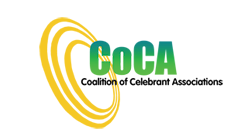Coalition of Celebrant Associations (CoCA) Suggested Approach to Assessment and Evidence Requirements for Marriage Celebrancy Units
CHCCEL007 Prepare for, present and evaluate marriage ceremonies
Suggested assessment activities:
Applied legal and other knowledge by creating a checklist of the factors that need to be considered in preparation for the wedding and rehearsal for each of the following
- a wedding for a couple with two (2) witnesses at your home
- a wedding for twenty (20) guests in a national park with a bridal party of two (2) groomsmen and two (2) bridesmaids, including a reader
- a wedding for 140 guests at a local reception function house in their garden area, with a bridal party of four (4) groomsmen and four (4) bridesmaids, two (2) page-children, two (2) readers,
- a wedding for forty (40) guests in a local park conducted in conjunction with an unauthorised religious minister
- a wedding for sixty (60) guests on a rock platform at the north end of the beach with a bridal party of a groomsman and a bridesmaid, a reader and a singer
and included the arrangements for the couples to make alternative venue plans if the weather were required to change
Applied legal and other knowledge by creating a detailed marriage ceremony checklist covering the section “Conduct marriage ceremonies in line with legal requirements, ceremony agreements with couples and expectations of couples, guests and others”; arranged and performed a mock rehearsal with the couple, bridal party, readers and observer to complete ceremony review checklist and submitted all completed observation forms duly signed by all the participants
Compared and contrasted relevant sections of the Marriage Act and the Sections 5,6 and 7 Marriage Guidelines to identify essential requirements and best practice for the matters and circumstances raised in the Marriage Guidelines
Analysed at least ten (10) scenarios of things that can go wrong or have gone wrong in marriage ceremonies, and documented strategies that could be employed by the celebrant in these to minimise or avoid problems to prepare own contingency plans
Designed a wedding ceremony review form and its accompanying covering letter to be sent to the couple after the ceremony and identified at least one other method of gaining feedback from the couple about their marriage ceremony and the performance of the celebrant and others involved in their wedding
Prepared, conducted, documented and reviewed as celebrant three (3) mock marriage ceremonies (chosen from those previously created by the student or newly created by the candidate) in line with legal requirements and professionalism, for each of the following situations
- first marriage where both are under 35 years, where the wedding was for 140 guests at a local reception function house in their garden area, with a bridal party of four (4) groomsmen and four (4) bridesmaids, two (2) page-children, and two (2) readers
- second marriage of couple with teenage or younger children from a previous marriage,
- a wedding for sixty (60) guests on a rock platform at the north end of the beach with a bridal party of a groomsman and a bridesmaid, a reader and a singer
- second marriage of an older couple with adult children, a wedding for twenty (20) guests in a national park with a bridal party of two (2) groomsmen and two (2) bridesmaids and a reader
The documentation for this assessment included a scripted copy of each ceremony, and the assessment covered the following criteria
- appearance
- manner and demeanour
- confidence and a sense of “being in control”
- stance
- audibility
- ability to use PA equipment
- use of notes, script and lectern, if used
- appropriate “gravitas” particularly around the significance of the legal elements of the marriage ceremony
- presentation and performance techniques
- smooth delivery and flow
- pace, pause, volume, articulation, modulation, use of varied vocal expression
- facial expression, eye contact, body language, use of gesture
- avoiding distracting mannerisms or facial expressions
- ability to work within the ceremonial space
- confident inclusion of symbolic items and movements
- connection with couple, other “up front” participants and audience
- creation of an “atmosphere” that enhances the ceremony for inclusion
N.B. Where the ceremony was presented as a role-play, the candidate ensured that there was no doubt that the ceremony was a mock situation for training purposes only and not in any way a legal ceremony as required by marriage legislation
- the advantages and disadvantages of reviewing the performance of the celebrant throughout their engagement with the couple, the wedding ceremony itself, how others involved in the wedding affected the ceremony and experience for the couple
- a personal review including strengths & areas for improvement, and
- a list of possible actions the celebrant could take to improve the quality of the marriage services provided
- a list of possible professional development activities that could aid in improving the quality of marriage ceremonies and services provided.


